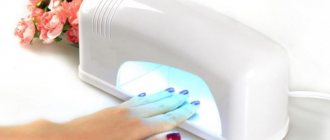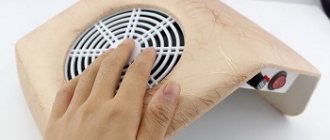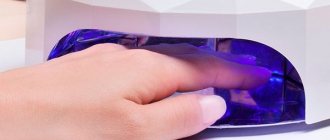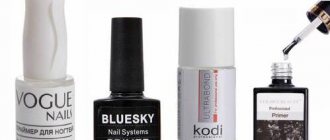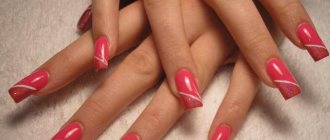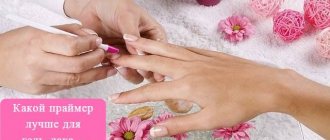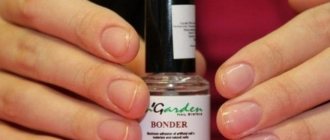There is no need to dry the primer in a lamp; the technology for its use does not provide for this. It should evaporate in air within 30-60 seconds if you place your hand flat on the table, fingers slightly apart. The acid-free one leaves a transparent, slightly sticky and shiny film, while the acidic one leaves a whitish coating.
You can dry the product faster in a lamp by placing your hand there for 20-30 seconds. But this is sometimes necessary when nails are wet. A primer is required when doing extensions; it is also not polymerized during the procedure.
Do I need to dry the primer in a lamp?
Usually there is no need to dry the primer in a lamp, since it does not contain polymerizing components. This liquid is intended for:
- removing excess moisture from the nail surface;
- slight loosening of the outer layer of the plates to more firmly secure the base on them.
The gel polish coating is quite thick compared to regular polishes and can come off the nails quickly. To make it last longer, use a primer. It contains methacrylic acid, ethyl acetate, hydroxyethyl methacrylate. All substances have a watery consistency and dry out when exposed to air.
Sometimes the primer needs to be dried in a UV lamp, but this is if:
- nails are naturally very wet;
- I want to save time.
By placing your hand in the “stove”, you can speed up the process. But this will not be polymerization. The radiation causes the liquid to heat up, causing it to dry in a matter of seconds.
It is not advisable to dry an acid primer in a lamp. Unlike acid-free, it contains a high concentration of methacrylic acid. But the product has a rather aggressive effect on the nails: it dries out their surface layer and loosens it more actively.
Therefore, acidic liquid is used for very wet plates on which the coating does not adhere well. And you shouldn’t supplement its influence by drying it in a lamp. This can easily damage your nails to the point where you will have to give up gel polish for a while.
Bluesky
There is no need to dry Bluesky primer in a lamp. It quickly evaporates from the surface of the nails in the air, leaving a slight stickiness. If they are basically wet and the coating does not stick very well, you can put your hand in the lamp after applying the composition for 20-30 seconds.
Bluesky may feel too sticky after drying. Therefore, some people think that it needs to be polymerized, but in fact the primer should be like that. After all, it ensures adhesion of the material to the nail plate. And if the base doesn’t fit well with Bluesky, most likely the products don’t fit together. Or the primer is applied too thickly, whereas it should be applied very thinly.
Acid-free
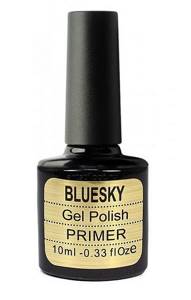
The acid-free composition also does not require intensive drying, and it does not polymerize. Therefore, immediately after applying it, a lamp is not needed. The primer with 5% methacrylic acid evaporates on its own within 1-2 minutes. A slightly damp film should remain on the nails, sometimes mistaken for a wet layer. They are trying to polymerize it under a lamp.
Acid-free composition
The liquid has no shade, odor, and the consistency is thin, watery or gel-like. The container in which the primer is stored is colored, as this increases shelf life and protects the composition from sunlight. The product includes the following components:
- Methacrylic acid;
- Ethyl acetate;
- 2-hydroxyethyl matacrylate.

The main component is methacrylic acid, due to which adhesion occurs. But it is precisely this that has an aggressive effect on the nail. Acid-free liquids were the first to be invented, and then a more effective acid primer appeared. However, it is not suitable for all plates. Weakened nails will not withstand acid and will become brittle and rough.
Therefore, an acid-free primer is a coating option that is gentle, does not bleed into the record, and prevents dehydration. Moreover, it contains a solvent, without which there can be no adhesive effect. However, such a remedy poses less of a risk of burns or inflammation.
If your nails are healthy, strong, and have no defects, then use a liquid with acid - it will keep your manicure longer.
How to dry primer and when to apply
The primer should simply be air dried. In order for the alcohol components of the liquid to evaporate faster, you need to place your hand on the table, palm down. It is better to keep your fingers open. And you need to try not to tilt your arm to the side. Don't shake your fingers either. If too much liquid is applied, it may spread unevenly on the nails.
The primer is used after a hygienic manicure is performed:
- nails are shaped;
- the overgrown part of the cuticle was removed, the pterygium was cleaned;
- the skin around the nails is sanded;
- The surfaces were treated with a buffer and wiped with a degreaser.
Applying primer is the next step. It is applied to clean nails, that is, there should be no sawdust or skin particles on their surfaces.
Look at the video about what a primer is, how to apply and dry it:
The varnish has expired
Do not neglect the expiration date indicated at the bottom of the bottle or on the label. As a rule, the shelf life of varnish is from 1 to 3 years from the moment the bottle is opened.
Important! Often the varnish can simply stagnate or become thick if it is not used for a long time, which also makes it take a long time to dry. In this case, you should first check whether its expiration date has expired, and then “reanimate” it by rolling it in your palms. It is not recommended to shake this varnish.
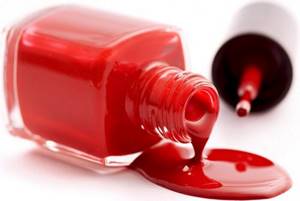
All gel polishes have a limited shelf life
How long to dry the primer in the lamp
If you need to speed up the manicure process, dry the primer in a lamp for no more than 20-30 seconds. Longer exposure can lead to brittle nails, but they are still exposed to light radiation. In air it evaporates in 30-60 seconds.
How long the primer should dry is easy to determine by the appearance of the nail plates. The acidic product dries and leaves a white coating on them. And the acid-free one lays down with a transparent film and gives the surfaces a slight gloss. There is no need to be afraid of stickiness; it does not indicate that the primer has not dried out. This property provides more reliable adhesion to the base product.
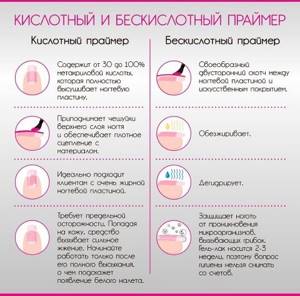
What to look for when choosing a product
The modern market provides a huge number of products in the beauty industry. How to choose the appropriate type of product and which company to pay attention to depends only on your personal desires and financial capabilities. To do this, the following selection criteria should be taken into account:
- Value for money. A quality base must match the price. But you don’t have to pay attention only to expensive companies. For example, Kodi gel polishes are of decent quality and average price.
- Components that affect the application method. Remember that it is better to choose the base and top from the same manufacturer. Their composition is designed to complement each other. A base with keratin strengthens the surface of the nails and creates a long-lasting manicure. Many masters use this base separately for nail care.
- Density and structure. It is necessary to take into account the consistency of the base itself. Very liquid will flow down and fall on the cuticle and side ridges. The dense base does not flow onto the cuticle and has the property of being evenly distributed on the surface of the nail.
- Structure of the nail plate. For damaged and weakened nails, a base coat with added vitamins is produced. They have a dense structure, which allows you to hide defects on the nails.
Do I need to dry the base?
The base must be dried, unlike the primer. It contains polymers, rubber, other light-curing components, and sometimes silicone. The product hardens only in a lamp for 2 minutes if it is ultraviolet, and in 30-60 seconds in an LED device. If the exposure time of the product under radiation is reduced, it dries poorly. And then problems may arise:
- colored gel polish cannot be applied evenly, and during polymerization it sometimes wrinkles;
- the coating will not last until correction and may come off entirely long before 2-3 weeks;
- Detachments also appear in places and are hardly noticeable, but there is a high risk that fungus will grow under them, or bacteria will get into the cavity.
The base is applied directly onto the dried primer. Sometimes the hand has to be placed in the lamp after using it for each nail, rather than all at once. This is done by inexperienced craftsmen or those whose product has a liquid consistency. In both cases, it spreads quickly and can get on the cuticle. Therefore, it is better to dry each nail separately.
If the base is not cured under a lamp, it will remain sticky. It will not be possible to apply gel polish on it; it will simply drain, mixing with the transparent substance. But the base should be dried after using its second layer. The first is applied thinly, using rubbing movements. And the second is a drop, leveling the nail plate.
An option for beginners so as not to get lost in the mass of bottles
In other words, we will talk about single-phase gel polish. And in this case, the sequence of applying gel polish will be reduced. An excellent option for those who prefer plain painted nails without any decoration. On the other hand, you can decorate it, but in this case you will still have to use a top coat to protect the decorative elements of the manicure.
A single-phase gel polish combines a base, or base, a pigmented layer, and a top coat. Thus, you have three different bottles in one. But, like any barrel of honey, there is a fly in the ointment. When you use all products individually, the top coat creates a surface that is protected from external influences. In the case of single-phase varnish, all chips and scratches will be more visible.
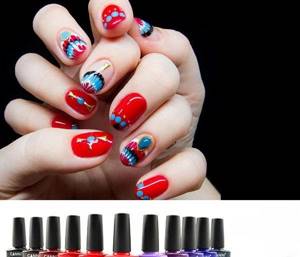
So the choice is yours. In any case, you can always try, experiment and choose the most optimal option for you.
Is it possible to grow nails without primer?
It is possible to grow your nails without a primer, but you will have to prepare for the fact that they will not last long. The procedure is performed when the plates are short, and the length is made using polymerizing gels, including acrylics.
In fact, the entire free edge is an artificial material that is a single whole with what is laid on the entire nail. That is, it is significantly larger in comparison with what is available when performing colored gel polish coating. Therefore, the adhesion to the natural nail should be stronger. And good adhesion will be ensured only by a correctly selected primer. Simply degreasing surfaces and using high-quality materials is not enough.
Without a primer, your nails will peel off completely or break off at the ends, which can become quite painful.
Another important task of the product is to create a sterile environment between living marigolds and artificial material. The primer will not allow microorganisms to survive and multiply, that is, you will not have to be afraid of fungus and Pseudomonas aeruginosa. Without it, when detachments form, bacteria may enter the resulting “pocket.”
What analogues are there?
It happens that at the wrong moment the bond is not at hand. Then, instead of a degreaser, use nail polish remover. The properties of acetone provide a drying and cleansing effect. However, without oils, the solvent causes harm to nails and skin. In order to prepare the nails for coating, it is enough to spread a thin layer of a mixture of acetone and vegetable oil (rosemary, orange, ylang-ylang, etc.) over the surface.
You can replace the bond with vinegar or alcohol. The proposed products will cope with the degreasing function. But they are unable to lift the scales of the upper layer of the nail structure. This does not increase the adhesive qualities of layers of decorative coatings.
Using boric acid, you can properly prepare the work surface for coating with varnish or shellac. Cologne and herbal tincture with alcohol will also provide a degreasing effect. But they still won’t be an adequate replacement for bond.
Experts advise using substitutes in extreme cases. It's not worth saving on a bond.
Answers to popular questions from experts
Which primer is best to use?
Manicurists prefer to use acid-free compounds. They have good adhesion, but are not so destructive to nails. Acidic ones are used for very problematic hands, with damp skin and oily nail plates. And they should be applied only to the free edge, the ends. But for the main part they still take an acid-free product.
Do I need a degreaser if I use a primer?
When using an acid-free product, a degreaser is needed. It not only removes epithelial particles remaining after processing with files and cutters, but also additionally removes excess moisture. The acid primer itself dries the plates well. Therefore, they do not use a degreaser with it, but wipe the nails from dust with lint-free wipes.
Price
How much does a primer cost? The price depends not so much on the type of product, but on the volume and brand of the manufacturer. Thus, the acid primer “Kodi” will cost 150 rubles for 10 ml, and the same product from the “Victory” brand will cost 300 rubles for 12 ml.
Many people believe that another primer will be cheaper. The price of an acid-free product is sometimes even higher. Thus, the “Naomi” product costs 180 rubles per bottle (12 ml), while “Gel Nail Prep Step 2” from an American manufacturer will cost at least 700 rubles (15 ml).
Improper storage of varnish
This product is especially sensitive to light, so for proper storage of gel polish you must follow the following rules:
- Always close the bottle of varnish to avoid the harmful effects of both UV lamps and sunlight. Exposure to light may cause changes in the structure of the product. This is why most manufacturers produce varnishes in dark bottles;
- Do a manicure in artificial light to protect the polish from the harmful effects of daylight;
- Store varnishes in dark places;
- Avoid temperature changes. Store the varnish in a place that guarantees a constant temperature of 26 degrees. If the temperature regime is violated, the life of the varnish is significantly reduced.
In addition, gel polish does not like shaking. When shaken, air bubbles form in the bottle, which cause poor surface quality.

